Abstract
A study on batter formulation effect on microstructural and physicochemical properties of deep-fat fried chicken nuggets coating was carried out. Two flour (wheat and rice) mixes at 5 ratios (100:0, 70:30, 50:50, 30:70, and 0:100) and two carboxymethyl cellulose ratios (0 and 1%) were combined. Samples were fried at 180°C for four min. Fried samples were then scanned with x-ray micro-computed tomography, and the obtained images were analyzed. Inclusion of hydrocolloid into the batter system significantly influenced their microstructural parameters. The number of pores, fragmentation index, and structure model index (shape) of the fried coating increased with the addition of hydrocolloid while porosity decreased. The proportions of rice or wheat flours in the batter affected porosity. Viscosity, batter pickup, color, texture, moisture, and fat content of the batter systems were significantly affected by the formulation. Some correlations were shown between the physicochemical properties of the batter system and the fried coating.
INTRODUCTION
Food coatings are applied for value addition especially in fried foods. They act as barrier to mass transfer during frying thereby reducing oil uptake and preventing moisture loss. They are also added to improve food texture, flavor, aesthetic appeal, weight and volume. Food coatings exist either as a batter and/or breading. They are usually made from a combination of flours or starch, water, seasoning and with or without leavening agent to form batter or breading/batter coating on foods. Batters can either be adhesive semi-liquid into which food is dipped and subsequently coated with breading or tempura, which usually contain leavening substance and applied solely to food surface. Batter formulation is extremely flexible, allowing for maximum adaptation to food product development. However, there has been some effort to relate their physical and chemical properties such as fat uptake, moisture loss, texture, structure, viscosity, thermal gelation to their composition and formulation.[Citation4,Citation6–10]
The formulation, composition, physicochemical properties and microstructural configuration of batter elements and their relationships are very significant in product development and quality definition.[Citation10] In order to meet today's sophisticated consumers' need for variety and convenient food items; meet the challenges of diversification and/proliferation of an automated food production system and the increased concern about fat content in fried foods, experimenting with formulation of batter system and relating their various properties is especially necessary.[Citation3,Citation10–13] Improved functionality and quality as well as cost effectiveness of combining two or more flours or the addition of other ingredients, such as hydrocolloids, are other major driving factor in batter formulation.[Citation4,Citation5,Citation14] Wheat flour is the traditional flour of choice for baking and coating application. Substitution of wheat flour with other flours such as rice flour could lead to value addition, increased appeal from the Asian-American market that has grown significantly in the last decade and a possible reduction in production cost of batter system.[Citation14–16] Rice flour based- batter could be alternative for individual with gluten allergies because it less allergenic than wheat flour.[Citation3] Rice flour has a better water holding capacity, therefore may reduce fat uptake than whole-wheat flour batter system[Citation17,Citation18] Xue and Ngadi[Citation4] suggested that rice flour-based batter could be healthier because they contain fewer calories. Also, the inclusion of hydrocolloids/gums into batter formula has been reported to improve the functional properties of batter system.[Citation19] Hydrocolloids are added to breading/batter system to control viscosity, batter pickup and the water holding capacity.[Citation20,Citation21] They undergo recoverable gelation in an aqueous medium when heated and this unique property helps to increase batter pick-up and to promote the barrier-resistant effecting oil uptake and moisture loss.[Citation22–24] The most used hydrocolloids in food applications are of the cellulose derivates such carboxymethyl cellulose (CMC), hydroxypropyl methylcellulose (HPMC), methylcellulose (MC). CMC is the least hydrophobic.
Recently, the study of food microstructural properties such as porosity, pore volume, pore size distribution and their relation to food properties has received attention. This is owed to the fact that most elements that determine food quality exist at a level <100 μm and the knowledge of their properties would be a major contribution to the development of tailored foods and effective tool in food system modeling and process optimization.[Citation25,Citation26] There is limited report in the literature on microstructural properties of deep-fat fried coating. Adedeji and Ngadi[ 27 ] reported the effect of processing conditions on porosity, pore size distribution, pore shape, and pore interconnectivity of deep-fat fried breaded chicken nuggets. Llorca et al.[Citation19] also reported on the microstructures of fried battered squid rings. Microstructural properties such as porosity, pore shape and pore interconnectivity are very important in modeling mass transfer during processing of porous foods, in quality improvement and evaluation, in process optimization and development of novel fried products. The objective of this study was to evaluate the effect of batter formulation on microstructural and physicochemical properties of fried chicken nuggets batter coating.
MATERIAL AND METHODS
Materials
The chicken breast and a brand name wheat flour (Five Rose All Purpose Flour, Les Cuisines Five Roses kitchens, QC, Canada) used for the study were procured from a local grocery store in Montreal, Canada. Long grain rice flour, RL-100, used was supplied by Rivland Partnership (Riceland Foods, Arizona, USA). The compositions of the two flours used are presented in in comparison with values reported for standard flour by USDA.[Citation28] Carboxylmethyl cellulose (CMC) used was supplied by (TIC Gums Inc., Maryland, USA). The chicken breast were cut into 5 × 5 × 1.2 ± 0.1 cm and stored in Zip-lock bags at frozen conditions prior to use.
Table 1 Composition and particle size of wheat and rice flour
Batter Formulations and Pickup
Two flours were blended at five different ratios of wheat and rice flours namely 100:0; 70:30; 50:50; 30:70, and 0:100, respectively. A fixed quantity of leavening agent (Sodium hydrogen bicarbonate, NaHCO3, H. Cantin Ltd, Quebec, Canada) and salt (NaCl) were added at 0.5% and 1%, respectively, to all the samples. Batter slurry was prepared by adding water to flour mix in the ratio of 1.5: 1. The system was thoroughly mixed with the aid of a kitchen mixer (B-Speed Mixer, Black and Dekker, ON, CA). Weighed chicken samples were dipped into the batter system for about 30 s and allowed to drip for 25 s and was immediately fried. The batter pickup was calculated as the difference in weight of the batter before and after dipping, divided by the initial weight of the chicken multiplied by 100.
Flow Behavior
The study of flow behavior was conducted using a strain/stress control Rheometer (Advanced Rheometer 2000, TA Instruments, Delaware, USA) equipped with a 4 cm diameter parallel plate. The gap between the plates was set to 1 mm, which was considered large enough with regard to the flour particle size. Approximately 1.2 ml of the sample was placed at the center of the Rheometer platform and the free surface of the sample edges was covered with silicone oil and a steel cover to minimize water loss during the measurements. The flow behavior (viscosity and the power index values) of the batter systems were determined over a shear rate range of 2–150 s−1 at 25°C. Apparent viscosity was reported as the mean of three replicates on each sample.
Frying
The coated samples were fried at 180°C for 4 min in a programmable fryer (Henny Penny Computron 7000 pressure Fryer, Model 500C, HP Corporation, Eaton, OH, USA), with capacity of 30 L. They were drained, cooled down to room temperature (25°C + 1), and stored in Zip-lock bags prior to further analysis.
Moisture Content
The moisture content of the samples was determined on a dry weight basis by placing samples in an oven at 105°C for 24 h. Weight before and after heat treatment was taken for computation.
Fat Content
Fat content was determined by following the modified AOAC method 960.39.[Citation29] Samples of 7–10 g were freeze-dried and ground in a blender (Bodum 5678-57, C-Mill, USA), and placed in thimbles in a VELP SER 148 (Velp Scientifica, Usmate, Italy) solvent extraction unit and oil was extracted with petroleum ether. The oil content was computed on dry weight basis by dividing the mass of extracted oil with the mass of freeze-dried sample.
Color Measurement
The surface color parameters of the coated fried samples were measured based on CIE system by a colorimeter (Minolta Spectrophotometer CM-3500d, Japan). The color parameters L* (lightness), a* (redness), b* (yellowness), chroma (C) and Hue angle (H) values of the samples were obtained.
Instrumental Texture Analysis
The textural properties of the fried coated samples were measured using an Instron Universal Testing machine (Instron Corporation, Canton, MA). Multiple probe of six heads with 3 mm diameter each were applied to the sample few minutes after frying at cross head speed of 10 mm/min and a load of 50 kN. The penetration depth of the probes set was 7.5 mm. The load versus displacement graph was plotted and the maximum penetration load was obtained.
X-ray MicroCT Scanning and Image Processing
The fried coatings were cut into 1 × 1 × 0.5 (±0.1) cm and wrapped in parafilm to prevent drying out during scanning. The samples were scanned in an X-ray micro-CT scanner (1076 Skyscan, Belgium) at the following settings: 100 keV, 98 μA, 6.0 s exposure time, 0.7° rotational step and a magnification of 30 × was achieved. The obtained images were reconstructed into series of 2-D images using reconstruction software (Nrecon, Skyscan, Belgium) that operates based on filtered back-projection algorithm.[Citation30,Citation31] A total of 916 slices of 2-D images were obtained in 8-bit bitmap (1024 × 1024 pixels; 18.75 μm/pixel) for each sample and analyzed (Nrecon and CTAnalyzer, respevtively, Skyscan, Belgium) by following the procedure of Adedeji and Ngadi.[ 27 ] The 3-D models were developed using CTvol software. Structural parameters such as porosity, fractal dimension, fragmentation and structure model index were determined. Porosity was obtained by dividing the digitally measured volume of pores by the volume of the solid structure of the sample. Structure model index (SMI) determination is based on dilation of the 3D voxel model of the sample, i.e.by artificially adding one voxel thickness to all binarized object surfaces. SMI is defined by this equation[Citation32]:
Statistical Analysis
All treatments were applied in triplicates. Analysis of variance was performed using SAS 8.2 version (SAS Inst. Inc., Cary, N.C., U.S.A.)[Citation37] to determine the effect of formulation on various properties of the samples. Duncan multiple range test was used for mean separation at P < 0.05 where treatment effect was significant.
RESULTS AND DISCUSSION
The grayscale and binarized images of chicken nugget coating formulated by a mixture of 100% wheat flour and 1% CMC are shown in . The image pre-processing step of segmentation by thresholding led to delineation between the pores and the rest of the constituent of the sample. The scale for thresholding was chosen by performing automatic thresholding on grayscale 2-D slices of the image using Otsu's algorithm[Citation38] such that the optimal threshold was used to maximize the interclass variance between the dark and bright region of the grayscale image. Three-dimensional models were developed by digitally stacking binarized 2-D images together.
Figure 1 Grayscale and binarized image of a formulated coating (100% wheat flour + 1% CMC) of deep-fat fried chicken nuggets.
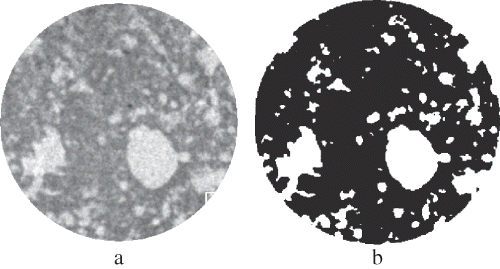
(A– F) are 3-D images of batter coating of deep-fat fried chicken nuggets. There is evidence of varied porosity attributable to batter formulation. showed that inclusion of CMC hydrocolloid into the 100% flour decreased the amount of pores developed during frying. However, inclusion of rice flour into the formulation reversed the decrease in pore development observed. More pores were noticeable in the coating that contained 30% rice flour () compared to the later samples. –F showed a decreasing trend in pore formation during frying as a result of increased rice flour addition into the formulation. However, there seem to be formation of larger pores with increase in the proportion of rice flour in the coating formulation.
Figure 2 Three-dimensional images of formulated batter coating of fried chicken nuggets: (A) 100% wheat flour; (B) 100% wheat flour plus 1% carboxymethyl cellulose (CMC); (C) 70% wheat flour + 30% rice flour + 1% CMC; (D) 50% wheat and rice flours + 1% CMC; (E) 30% wheat flour + 70% rice + CMC; (F) 100% rice flour + 1% CMC. (Figure provided in color online.)
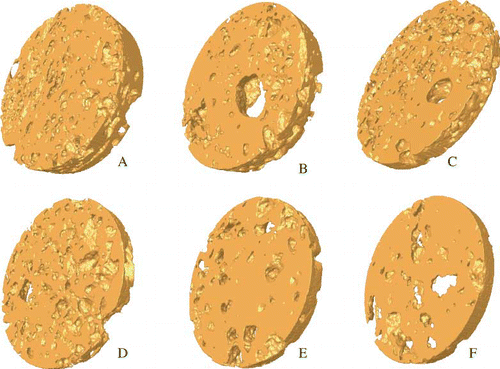
The fried batter pore size ranged from 19.0–582 μm. Adedeji and Ngadi[ 27 ] have reported a range of 9.0 to 253 μm for commercially procured chicken nuggets breading coatings fried at 180°C. The disparity between their result and this study could be attributed to the difference in coating formulation. The pore size distribution of fried batters as affected by formulation is shown in . The graph shows a bimodal pore size distribution, with two peaks around 94 to 169 μm and 544 to 582 μm. Datta et al.[Citation39] also reported a bimodal pore size distribution for bread baked using different heating modes. Karathanos and Saravacos[Citation40] reported a bimodal pore distribution pattern using mercury intrusion porosimetry for granular and unpressed Amioca starch that contained 11% moisture. The bimodal pore size distribution may be typical of most porous foods. There was a general increase in pore volume frequency for all the fried batter coating between 19 and 131 μm after which the volume percentage starts to decline. However, batter formulated with 100% rice and 1% CMC hydrocolloid showed an increase beyond 131 up to 206 μm after which a plateau was reached. Fried batter with 100% rice flour and 1% CMC tends to show an equal distribution of pore volume over the size range between 131 to 469 μm. Batter formulated with 100% wheat flour without CMC addition showed a very high percentage of volume (23.5%) for large pores (544–582 μm) compared to others (). This could be as a result of the leavening effect of baking powder and the viscoelastic texture of the batter system which supports development of larger porous network before and during frying.[Citation19] Overall, pores with size range between 19.0 to 244 μm constitute more than 60% of the pore volume for all the samples, implying majority of the pores for all the samples were within this range. Increased addition of rice flour into the batter mix resulted in decreased pore volume for pores between 19.0 and 169 μm and an increased pore volume from 244 to 431 μm.
Figure 3 The bar chart of pore volume frequency over the pore size distribution. (Figure provided in color online.)
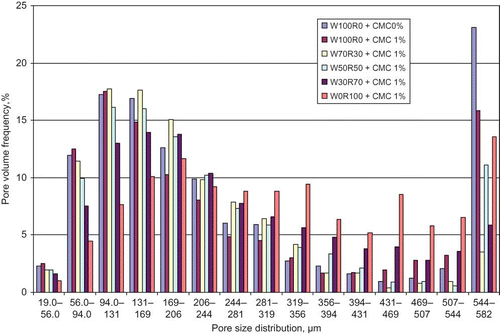
The plot of cumulative pore volume as a function of pore size distribution is presented in . There was a gradual increase in cumulative pore volume as the pore size increased for all the samples, especially between 20 and 300 μm pore size. Beyond 300 μm pore size; there was minimal increase in cumulative pore volume indicating that there were fewer large pores in all the samples. The cumulative pore volume varied from 3.11 to 4.93 mm3 for all the batter formulation. Fried batter system with 100% wheat flour and 1% CMC hydrocolloid addition developed the least pore volume. This would be significant in its mass transfer characteristics.[Citation24] The sample formulated with 50% wheat and rice flour plus 1% CMC showed the highest volume. There was no particular trend shown for the cumulative pore volume based on the formulation.
Figure 4 The cumulative pore volume against pore size distribution. (Figure provided in color online.)
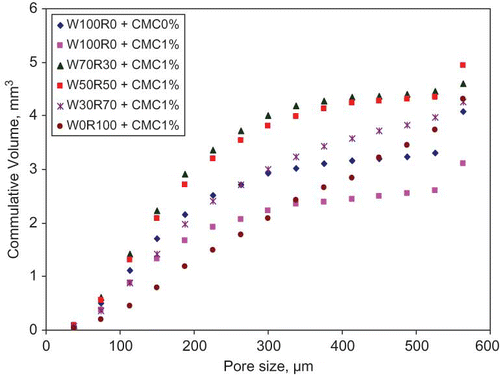
The pore characteristics of the samples as measured using images obtained from X-ray micro-computed tomography (CT) are shown in . Analysis of variance (ANOVA) showed that batter formulation significantly (P < 0.05) affected the porosity, fragmentation index (FI) and the total number of pores. Structure model index (shape), object surface to volume ratio (PSA/PV) and the fractal dimension of the pores were not significantly influenced by formulation. The addition of 1% CMC hydrocolloid into the batter system of the sample did not significantly influence porosity although it led to a substantial decrease of about 25% (). The addition of hydrocolloids has been reported to increase water holding capacity of samples and subsequently a reduced porosity.[Citation41,Citation42] However, when wheat flour was substituted by 30% rice flour, porosity suddenly increased significantly (P < 0.05) when compared to batter with 100% wheat and 1% CMC. The change was insignificant when compared to the control (batter with 100% wheat flour) Increasing the proportion of rice flour in the batter did not change porosity further.
Table 2 Pore parameters of deep-fat fried chicken nuggets coating formulated from wheat and rice flour and fried at 180°C for 4 min
SMI values for the samples ranged between 2 and 3. This shows that majority of the pores fall in the bracket of cylindrical/rod shapes. There was no significant effect of batter formulation on the shape of the pores developed. The addition of CMC hydrocolloid into the 100% wheat flour formulation led to significant increase in pore fragmentation, but this decreased as rice flour was included into the formulation. The increased fragmentation of the pores with inclusion of CMC might be due to the gelation of the gum within matrix of the batter system, forming in the pathways of the pores created during frying. The ratio of pore surface area to pore volume (PSA/PV) was not affected by affected by either inclusion of CMC or substitution of rice flour. Fractal dimension describes the surface roughness of the pores, which remained almost the same for all samples. The addition of CMC increased the pore count in the fried coating substantially (P < 0.05), which decreased when wheat flour was substituted with rice flour in the batter system.
The initial moisture content of the batter systems before frying ranged from 1.50 to 1.83 (g/g, db) and these are not significantly different (P < 0.05). The results of fried batter final moisture and fat content are shown in and . Final moisture and fat content ranged from 0.49 to 0.816 (g/g, db) and 0.051 and 0.136 (g/g, db), respectively. The effect of composition was significant (P < 0.05) on the variation observed in moisture and fat content of the fried batter systems. The addition of CMC caused an increase in moisture content, which decreased as the level of rice flour inclusion in the formulation increased (). The increase recorded for moisture content after the addition of CMC was expected because of the better water holding capacity of the hydrocolloid.[Citation41,Citation43] However, the moisture content saw a significant decrease as rice flour was included into the formulation. The decrease was not significantly different from the batter system that contained 100% wheat flour with no hydrocolloid addition. This is indicative of decreasing water-holding capacity with increased rice flour addition into the batter system contrary to expectation, which could be a result of increased flour particle size (). Maskat and Kerr[Citation44] recorded lesser moisture content in chicken nuggets coating with large particle size compared to the one with smaller size particle size.
Figure 5 Moisture content of batter fried at 180°C for 4 min as a function of the coating formulation: (A) 100% wheat flour; (B) 100% wheat flour plus 1% carboxymethyl cellulose (CMC); (C) 70% wheat flour + 30% rice flour + 1% CMC; (D) 50% wheat and rice flours + 1% CMC; (E) 30% wheat flour + 70% rice + CMC; (F) 100% rice flour + 1% CMC.
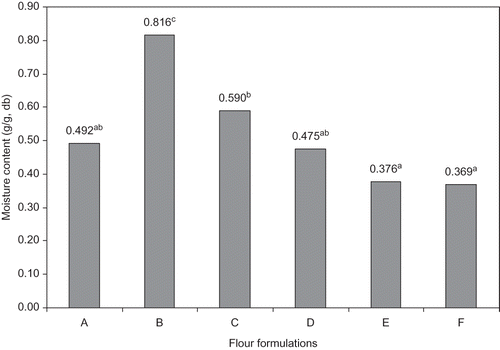
Figure 6 Final fat content of the coating (fried at 180°C for 4 min) plot against the batter formulation: (A) 100% wheat flour; (B) 100% wheat flour plus 1% carboxymethyl cellulose (CMC); (C) 70% wheat flour + 30% rice flour + 1% CMC; (D) 50% wheat and rice flours + 1% CMC; (E) 30% wheat flour + 70% rice + CMC; (F) 100% rice flour + 1% CMC. (Figure provided in color online.)
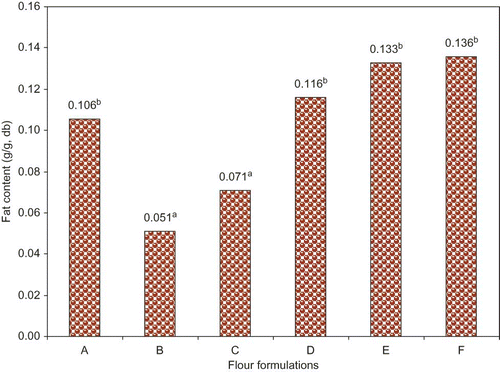
The change in composition of the batter system due to addition of 1% CMC and 30% rice flour led to a significant (P < 0.05) decrease in fat content (), which could be due to gel forming properties of the hydrocolloid, which created a barrier film on the sample leading to a reduction in fat uptake. Other authors have reported the effectiveness of hydrocolloid addition and rice flour inclusion into batter formulation for fat reduction in fried foods.[Citation17,Citation23,Citation24,Citation41,Citation45][Citation16,Citation20,Citation22,Citation32,Citation39] A significant increase in fat absorption was shown when higher proportion of rice flour (≥50%) was added to the formulation, but compared to the whole wheat flour and no CMC batter, the change was insignificant. This increase could be a result of increased particle size (lower damaged starch) and lower protein content of the flour mix when rice flour was added ().[Citation18,Citation46,Citation47] The increased particle size might have reduced the water holding capacity of the flour mix, which is evident in the moisture content and porosity of the fried samples reported earlier. The impact of this is in reduced gelation and less barrier formation during frying leading to higher fat absorption. Mohamed et al.[Citation2] reported increased fat uptake with fried pre-gelatinized and glutinous rice flour batter compared to control. They attributed that the increase was due to reduced amylose content of the sample, which would have otherwise help inhibit oil absorption. However, Dogan et al.[Citation17] reported a reduced fat absorption with inclusion of 5% rice flour into the batter system of fried chicken nuggets. Their result is comparable to this study at the level of rice flour used. Shih and Daigle[Citation18] also presented different oil uptake percentages based on varying chemical constituent (wheat/rice flour ratio, protein level, starch form) of the chicken drumstick's coating. The level of rice flour inclusion, particle size and chemical content determines the effect of rice flour on fat absorption.
shows the effect of formulation on the viscosity of unfried batter system. Addition of CMC into the formulation resulted in a significant increase in batter viscosity. Christianson et al.[Citation48] and Shi & BeMiller[Citation49] reported a significant increase in viscosity of wheat starch by the addition of a small amount of xanthan, guar, and cellulose hydrocolloids. Inclusion of rice flour beyond 30% level resulted in a decreased viscosity. This might be due to interaction between the constituent of the batter formulation. Obviously, the water content of the samples started to reduce when 50% of wheat flour was substituted by rice flour (), which precipitated the reduction in viscosity. The viscosity of all the batter systems decreased with increasing shear rate, indicating a pseudoplastic behavior synonymous with non-newtonian shear shinning fluid that is very significant in processing and application of viscous materials. These can be modeled by the power law expression EquationEq. (3):
Table 3 Power law properties of batter with different composition of wheat and rice flour, and CMC content
Figure 7 Batter viscosity for different flour formulation as a function of shear rate. (Figure provided in color online.)
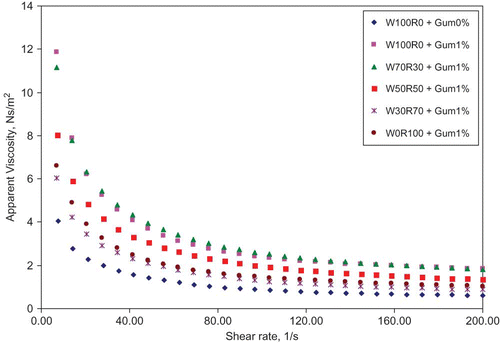
presents the batter pickup values obtained after coating the chicken meat with the formulated batter systems and the energy to break point (indicating crispiness/hardness) obtained after frying. The batter pickup values varied from 45.11 to 72. 21%. The composition of the batter significantly (P < 0.05) affected batter pickup. As expected, inclusion of hydrocolloid (CMC) and rice flour into the formulation led to increased batter pickup, which might be due to increased water holding capacity and viscosity as shown in and . Akdeniz et al.[Citation8] reported increase in batter pickup for batter formulation when higher levels of pregelatinzed tapioca starch were used. However, a gradual reduction in batter was observed after the level of rice flour in the batter system increased beyond 30%. This trend was observed for viscosity of the batter and final moisture content of the fried sample, which also showed in the amount of fat absorbed. Rice flour has been reported to have low thickening capability, thus forming thin layer when coated on food material.[Citation14,Citation17,Citation18] This obviously was due to change in chemical constituents of the batter and the flour particle size especially when rice flour inclusion increased (). Decreasing protein content has been reported to reduce batter pickup, viscosity and water holding capacity.[Citation48] The energy to break point of the fried batter saw a significant (P < 0.05) increase when hydrocolloid was included and as the level of rice flour increased. This is an indication of increased crispiness as hydrocolloid was added and the wheat flour was substituted with rice flour in the formulation. The formation of fewer and large pores as shown in the three dimensional images and cumulative pore volume reported initially could be the reason for increased load required for deformation when CMC and rice flour was added to the batter formulation. Shih and Daigle[Citation18] also reported increased hardness of fried batter as the level of rice flour inclusion increased.
Table 4 Batter pickup for the formulated coating and texture property of the fried
The L*, a*, b*, C* and H (°) color indices of the samples are presented in . Inclusion of CMC significantly increased the lightness value (L*) for the fried sample, which gradually increased as wheat flour was substituted for by rice flour. Batter with 100% wheat flour only and the one with ratio 3:7 of wheat and rice flour showed a much lower L* value indicating higher Maillard and caramelization reactions of the sugar and amino acid constituent. There was no significant difference in the values of a* index though there was an increase in the samples redness with inclusion of hydrocolloid and rice flour. Yellowness (b*) of the samples also increased with the addition of hydrocolloid and rice flour. Chroma value (C*) which is a measure of color saturation also increased with the same trend. Hue angle (H, °) remained almost the same for all the formulations.
Table 5 Color parameters as affected by coating compositions after frying
Table 6 Pearson correlation between microstructural parameter and some physicochemical properties of the fried batter coating
presents the Pearson correlation between the physicochemical properties of the formulated batter system. The correlation between the moisture and fat content was negative and significant at 95% confidence interval, implying almost a simultaneous diffusion of moisture and fat in and out of the batter during frying, respectively.[Citation50] There was a good positive correlation between the moisture content, batter pickup and consistency index. Texture and porosity correlated negatively with moisture content. Fat content was negatively correlated with batter pick up and consistency index while it showed positive correlation with texture and porosity.
CONCLUSION
Pore characteristics of formulated deep-fat fried chicken nuggets coating were elucidated using X-ray micro-CT technique. Porosity, fragmentation index of the pores and pore number were significantly affected by batter formulation. The effect of batter formulation on pore SMI, PSA/PV ratio and fractal dimension were less pronounce. Batter pickup and viscosity varied with the addition of carboxymethyl cellulose (CMC) and rice flour into the formulation. The addition of CMC into the formulation caused an increase in moisture retention and a corresponding decrease in fat uptake. Rice flour addition however, decreased moisture content and caused more fat to be absorbed. The addition of CMC and rice created a more crispy texture for the fried batter coating. There were some correlations shown among the physicochemical properties of the batter system and fried coating. Fat and moisture content showed significant negative correlation.
ACKNOWLEDGMENT
The authors express profound gratitude to Natural Science and Engineering Research of Canada (NSERC) for funding this project.
REFERENCES
- Pinthus , E.J. , Weinberg , P. and Saguy , I.S. 1993 . Criterion for Oil Uptake during Deep-fat Frying . Journal of Food Science , 58 ( 1 ) : 204 – 205 .
- Mohamed , S. , Hamid , N.A. and Hamid , M.A. 1998 . Food components affecting the oil absorption and crispness of fried batter . Journal of the Science of Food and Agriculture , 78 ( 1 ) : 39 – 45 .
- Fiszman , S.M. and Salvador , A. 2003 . Recent developments in coating batters . Trends in Food Science and Technology , 14 ( 10 ) : 399 – 407 .
- Xue , J. and Ngadi , M. 2006 . Rheological properties of batter systems formulated using different flour combinations . Journal of Food Engineering , 77 ( 2 ) : 334 – 341 .
- Xue , J. and Ngadi , M. 2007 . Rheological properties of batter systems containing different combinations of flours and hydrocolloids . Journal of the Science of Food and Agriculture , 87 ( 7 ) : 1292 – 1300 .
- Lee , S. and Inglett , G.E. 2007 . Effect of an Oat Beta-Glucan-Rich Hydrocolloid (C-trim30) on the Rheology and Oil Uptake of Frying Batters . Journal of Food Science , 72 ( 4 ) : E222 – E226 .
- Sahin , S. , Sumnu , G. and Altunakar , B. 2005 . Effects of batters containing different gum types on the quality of deep-fat fried chicken nuggets . Journal of the Science of Food and Agriculture , 85 : 2375 – 2379 .
- Akdeniz , N. , Sahin , S. and Sumnu , G. 2005 . Effects of different batter formulations on the quality of deep-fat-fried carrot slices . European Food Research and Technology , 221 ( 1 ) : 99 – 105 .
- Akdeniz , N. , Sahin , S. and Sumnu , G. 2006 . Functionality of batters containing different gums for deep-fat frying of carrot slices . Journal of Food Engineering , 75 ( 4 ) : 522 – 526 .
- Maskat , M.Y. and Kerr , W.L. 2004 . Effect of Surfactant and Batter Mix Ratio on the Properties of Coated Poultry Product . International Journal of Food Properties , 7 ( 2 ) : 341 – 352 .
- van Dalen , G. , Nootenboom , P. , van Vliet , L.J. , Voortman , L. and Esveld , E. 2007 . 3D Imaging and analysis of porous cereal products using X-ray microtomography . Image Analysis and Stereology , 26 : 169 – 177 .
- Heertje , I. 1998 . Fat crystals, emulsifiers and liquid crystals. From structure to functionality . Pol. Journal of Food Nutr. Sci. , 7 ( 48 ) : 7 – 18 .
- Rahman , M.S. 2001 . Toward prediction of porosity in foods during drying: a brief review . Drying Technology , 19 ( 1 ) : 1 – 13 .
- Mukprasirt , A. , Herald , T.J. , Boyle , D.L. and Rausch , K.D. 2000 . Adhesion of rice flour-based batter to chicken drumsticks evaluated by laser scanning confocal microscopy and texture analysis . Poult Sci. , 79 ( 9 ) : 1356 – 1363 .
- Puspitowati , S. and Driscoll , R.H. 2007 . Effect of Degree of Gelatinisation on the Rheology and Rehydration Kinetics of Instant Rice Produced by Freeze Drying . International Journal of Food Properties , 10 ( 3 ) : 445 – 453 .
- Loewe , R. 1993 . Role of ingredients in batter systems . Cereal Foods World , 38 ( 9 ) : 673 – 677 .
- Dogan , F.S. , Sahin , S. and Sumnu , G. 2005 . Effects of soy and rice flour addition on batter rheology and quality of deep-fat fried chicken nuggets . Journal of Food Engineering , 71 ( 1 ) : 127 – 132 .
- Shih , F. and Daigle , K. 1999 . Oil Uptake Properties of Fried Batters from Rice Flour . J. Agric. Food Chem. , 47 ( 4 ) : 1611 – 1615 .
- Llorca , E. , Hernando , I. , Pérez-Munuera , I. , Fiszman , S.M. and Lluch , M.A. 2001 . Effect of frying on the microstructure of frozen battered squid rings . European Journal of Food Research and Technology , 213 ( 6 ) : 448 – 455 .
- Rimac-Brncic , S. , Lelas , V. , Rade , D. and Simundic , B. 2004 . Decreasing of oil absorption in potato strips during deep fat frying. Journal of Food Engineering , 64 ( 2 ) : 237 – 241 .
- Mukprasirt , A. , Herald , T.J. and Flores , R.A. 2000 . Rheological characterization of rice flour-based batters . Journal of Food Science , 65 ( 7 ) : 1194 – 1199 .
- Dziezak , J.D. 1991 . A focus on gums . Food Technology , 43 ( 3 ) : 116 – 132 .
- Meyers , M.A. 1990 . “ Functionality of hydrocolloids in batter coating systems ” . In Batters and Breading in food processing , Edited by: Kulp , K. and Loewe , R. 123 – 130 . St. Paul , MN : American Association of Cereal Chemists Inc .
- Mellema , M. 2003 . Mechanism and reduction of fat uptake in deep-fat fried foods . Trends in Food Science & Technology , 14 ( 9 ) : 364 – 373 .
- Aguilera , J.M. 2005 . Why food microstructure? . Journal of Food Engineering , 67 ( 1–2 ) : 3 – 11 .
- Boukouvalas , C.J. , Krokida , M.K. , Maroulis , Z.B. and Marinos-Kouris , D. 2006 . Density and Porosity: Literature Data Compilation for Foodstuffs . International Journal of Food Properties , 9 ( 4 ) : 715 – 746 .
- Adedeji , A.A. and Ngadi , M.O. 2009 . 3-D Imaging of deep-fat fried chicken nuggets breading coating using X-ray micro-CT . International Journal of Food Engineering , 5 ( 4 )
- United State Department of Agriculture Nutritional value of Foods: NDB-20081 and 20061. Nutrient Data Laboratory USDA Washington DC 2008 http://www.nal.usda.gov/fnic/foodcomp/search/ (http://www.nal.usda.gov/fnic/foodcomp/search/)
- Association of Official Analytical Chemists . 1990 . Official methods of analysis , Washington , DC : Method No.: 960.39. AOAC .
- Sasov and Van , D. 1998 . Desktop X-ray microscopy and microtomography . Journal of Microscopy , 191 ( 2 ) : 151 – 158 .
- Feldkamp , L.A. , Davis , L.C. and Kress , J.W. 1984 . Practical cone-beam algorithm . Journal of the Optical Society of America A. , 1 ( 6 ) : 612 – 619 .
- Hildebrand , T. and Ruegsegger , P. 1997 . Quantification of Bone Microarchitecture with the Structure Model Index . Computer Methods in Biomechanics and Biomedical Engineering , 1 ( 1 ) : 15 – 23 .
- Skyscan. Structural parameters measured by the Skyscan™ CT-Analyser Version 1.7.0.5. Skyscan, Belgium http://www.skyscan.be/ (http://www.skyscan.be/) (Accessed: 7 April 2008 ).
- Hahn , M. , Vogel , M. , Pompesius-Kempa , M. and Delling , G. 1992 . Trabecular bone pattern factor--a new parameter for simple quantification of bone microarchitecture . Bone , 13 ( 4 ) : 327 – 330 .
- Chappard , D. 2001 . Fractal dimension of trabecular bone: comparison of three histomorphometric computed techniques for measuring the architectural two-dimensional complexity . The Journal of Pathology , 195 ( 4 ) : 515 – 521 .
- Skyscan. Structural parameters measured by the Skyscan™ CT-Analyser Version 1.7.0.5. Skyscan, Belgium http://www.skyscan.be/ (http://www.skyscan.be/) (Accessed: 6 April 2009 ).
- SAS . 1999 . SAS procedures guide Version 8.2 , 3rd Edited by: SAS Institute . Cary , NC
- Otsu , N. 1979 . A threshold selection method from gray-level histograms . IEEE Transactions on Systems, Man, and Cybernetics , 9 ( 1 ) : 62 – 66 .
- Datta , A.K. , Sahin , S. , Sumnu , G. and Ozge Keskin , S. 2007 . Porous media characterization of breads baked using novel heating modes . Journal of Food Engineering , 79 ( 1 ) : 106 – 116 .
- Karathanos , V.T. and Saravacos , G.D. 1993 . Porosity and pore size distribution of starch materials . Journal of Food Engineering , 18 ( 3 ) : 259 – 280 .
- Mallikarjunan , P. , Chinnan , M.S. , Balasubramaniam , V.M. and Phillips , R.D. 1997 . Edible Coatings for Deep-fat Frying of Starchy Products . Lebensmittel-Wissenschaft und-Technologie , 30 ( 7 ) : 709 – 714 .
- Ford , J.L. 1999 . Thermal analysis of hydroxypropylmethylcellulose and methylcellulose: powders, gels and matrix tablets . International Journal of Pharmaceutics , 179 ( 2 ) : 209 – 228 .
- Davis , A. 1983 . “ Breading and batter ingredients ” . In Breading and Batter Technology , Edited by: Suderman , D.R. and Cunningham , F.E. 125 Wesport , CT : AVI Publishing Inc .
- Maskat , M.Y. and Kerr , W.L. 2002 . Coating characteristics of fried chicken breasts prepared with different particle size breading . Journal of Food Processing and Preservation , 26 ( 1 ) : 27 – 38 .
- Sanz , T. , Salvador , A. and Fiszman , S.M. 2004 . Effect of concentration and temperature on properties of methylcellulose-added batters Application to battered, fried seafood . Food Hydrocolloids , 18 ( 1 ) : 127 – 131 .
- Olewnik , M. and Kulp , K. 1990 . “ Factors affecting characteristics of wheat flour in batter ” . In Batter and Breading in Food Processing , Edited by: Olewnik , M. and Kulp , K. 106 – 107 . St. Paul , MN : American Association of Cereal Chemists .
- Loewe , R. 1990 . “ Ingredients selection for batter systems ” . In Batter and Breading in Food Processing , Edited by: Olewnik , M. and Kulp , K. 11 St. Paul , MN : American Association of Cereal Chemists .
- Christianson , D.D. , Hodge , J.E. , Osborne , D. and Detroy , R.W. 1981 . Gelatinization of wheat starch as modified by xanthan hydrocolloid, guar hydrocolloid and cellulose hydrocolloid . Cereal Chemistry , 58 ( 6 ) : 513 – 517 .
- Shi , X. and BeMiller , J.N. 2002 . Effects of food gums on viscosities of starch suspensions during pasting . Carbohydrate Polymers , 50 ( 1 ) : 7 – 18 .
- Gamble , M.H. , Rice , P. and Selman , J.D. 1987 . Relationship between oil uptake and moisture loss during frying of potato slices from c. v. Record U.K. tubers . International Journal of Food Science & Technology , 22 ( 3 ) : 233 – 241 .